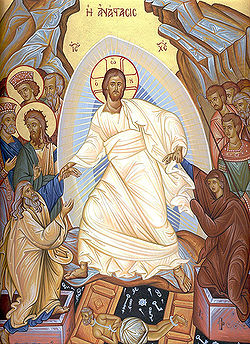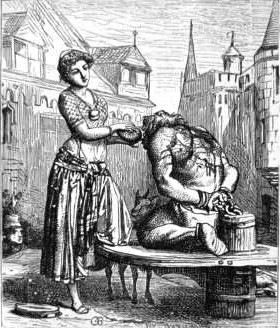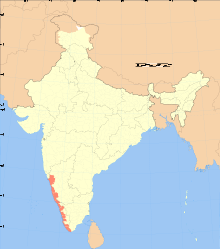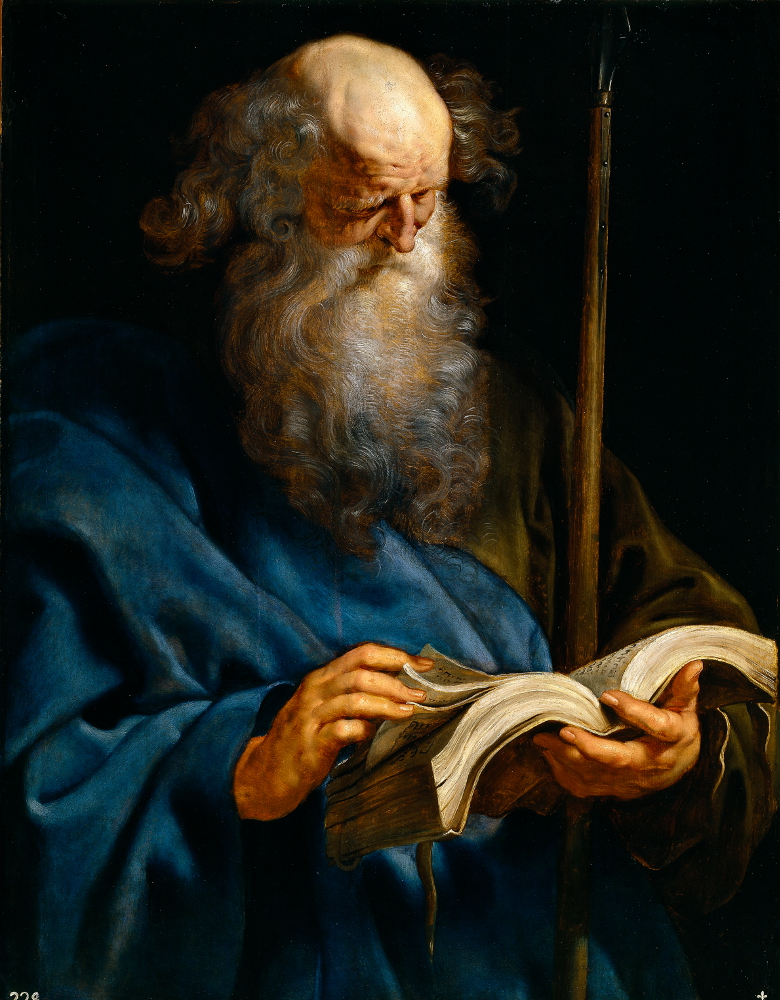
“Martyrdom of St. Thomas” – the original Doubting Thomas – on the Malabar Coast of India…
* * * *
 Today is officially the Second Sunday of Easter.
Today is officially the Second Sunday of Easter.
Note the “of,” rather than “after.” That’s because Easter is “not just one day, but an entire season.” It’s a full season of 50 days – called Eastertide – that runs from Easter Sunday to Pentecost. (See Frohliche Ostern, which includes the image at left.)
So while today is technically the first Sunday after Easter, it is better known as the Second Sunday of Easter. Actually, it’s really better known as Low Sunday. That’s mostly because church attendance falls off so drastically that first Sunday “after.” (Compared with the high attendance of Easter Day. See also “CEOs;” i.e., Christians who only go to church on Christmas and Easter.)
You could also call this day the “Sunday of Many Names.” For example, it’s known as “Doubting Thomas Sunday.” That’s mostly because the Gospel lesson always tells the story of the disciple Thomas. (See e.g. John 20:19-31, “which recounts the story of Christ appearing to the Apostle Thomas in order to dispel the latter’s doubt about the Resurrection.” Which made him in essence the original – the prototype – “Doubting Thomas.”)
And today is known as the Octave of Easter. (In this case the Octave in question is the eight-day period “in Eastertide that starts on Easter Sunday and runs until the Sunday following Easter.”)
 Finally, it’s known as “Quasimodo Sunday.” But that’s not because of Quasimodo, the guy – shown at right – who is better known as the “Hunchback of Notre Dame:”
Finally, it’s known as “Quasimodo Sunday.” But that’s not because of Quasimodo, the guy – shown at right – who is better known as the “Hunchback of Notre Dame:”
Instead, the name comes from a Latin translation of the beginning of First Peter 2:2 , a traditional “introit” used in churches on this day. First Peter 2:2 begins – in English and depending on the translation – “As newborn babes, desire the rational milk without guile…” [Or, “pure spiritual milk, so that by it you may grow up in your salvation.”] In Latin the verse reads: “Quasi modo geniti infantes…” Literally, “quasi modo means ‘as if in [this] manner.’”
Since “geniti” translates as “newborn” and the translation of “infantes” seems self-evident, the “quasi modo” in question roughly translates, “As if in the manner” (of newborn babes)… And incidentally, that character in The Hunchback of Notre-Dame was named after the opening words of First Peter 2:2. (See The Bible – Lectionary Musings and Color Commentary, and also First musings – The readings for “Doubting Thomas” Sunday, both from April 24, 2014).
 As Wikipedia noted, a doubting Thomas is “a skeptic who refuses to believe without direct personal experience, a reference to the Apostle Thomas, who refused to believe that the resurrected Jesus had appeared to the ten other apostles, until he could see and feel the wounds received by Jesus on the cross.”
As Wikipedia noted, a doubting Thomas is “a skeptic who refuses to believe without direct personal experience, a reference to the Apostle Thomas, who refused to believe that the resurrected Jesus had appeared to the ten other apostles, until he could see and feel the wounds received by Jesus on the cross.”
Aside from the posts noted above, I’ve written about this disciple in Doubting Thomas – and Peter Restored, and Doubting Thomas’ “passage to India.” The “Passage to India” post noted that according to tradition, Thomas became a missionary who traveled to India. That is, he sailed to India in the year 52 AD, to spread the Christian faith:
According to tradition, St. Thomas was killed in 72 AD[, possibly] at Mylapore near Chennai in India… This is the earliest known record of his martyrdom.. Some Patristic literature state[s] that St. Thomas died a martyr, in east of Persia or in North India by the wounds of the four spears pierced into his body by the local soldiers.
 Which is what the painting at the top of the page shows. Put another way, in his travels Thomas “ultimately reached India, carrying the Faith to the Malabar Coast” – shown at right in red, on the southwestern coast of India – “which still boasts a large native population calling themselves ‘Christians of St. Thomas.’”
Which is what the painting at the top of the page shows. Put another way, in his travels Thomas “ultimately reached India, carrying the Faith to the Malabar Coast” – shown at right in red, on the southwestern coast of India – “which still boasts a large native population calling themselves ‘Christians of St. Thomas.’”
On the other hand, the Peter Restored post addressed the question: If you doubt and question your faith – like Thomas did – will that faith actually grow stronger?
In other words, how do we as Christians deal with our doubts?
The theme of this post is that – for boot-camp Christians – the answer is simple: You shouldn’t have any doubts. In other words, you should “blindly believe.” But for the rest of us there’s another answer, and that answer ultimately provides a stronger Christian faith:
Remember Thomas, the disciple, who wouldn’t believe in Christ’s resurrection until he put his hand into Jesus’s wounds. He went on to die spreading the gospel in Persia and India. God gave us free choice, He doesn’t want us to be robots, He could have made us like that, but wanted us to choose for ourselves. You learn and grow by questioning. (E.A.)
And by doing that you’ll probably end up – spiritually anyway – like the kindly, gentle, learned disciple shown in the painting below. (Another view of St. Thomas by Peter Paul Rubens.) And that’s the kind of disciple who could convert people to Christianity even in a continent made up of Hindus and Muslims; that is, an otherwise unfertile continent for conversion, yet “which still boasts a large native population calling themselves ‘Christians of St. Thomas.’”
Which brings up The True Test of Faith. Somehow Thomas seemed to have the kind of faith that – even if he ultimately found that the whole “Jesus thing” was a hoax – he’d still end up saying, at the end of his life, “You know, I wouldn’t change a thing.”
* * * *

St. Thomas by Peter Paul Rubens…
* * * *
The upper image is courtesy of Thomas the Apostle – Wikipedia. The full caption: “Martyrdom of St. Thomas by Peter Paul Rubens.”
Re: “Low Sunday.” See Why Attendance Will Be Low This Sunday, and also Low Sunday | Article about Low Sunday by The Free Dictionary.
The Wikipedia caption for the image of Quasimodo reads: “Esmeralda gives a drink to Quasimodo in one of Gustave Brion‘s illustrations.”
Re Introit. Merriam-Webster defines it as either “the first part of the traditional proper of the Mass consisting of an antiphon, verse from a psalm, and the Gloria Patri,” or a “piece of music sung or played at the beginning of a worship service.” The Gloria Patri generally goes like this: “Glory to the Father, and to the Son, and to the Holy Spirit, as it was in the beginning, and now, and ever shall be, world without end. Amen.”
Re: “Both from April 24, 2014.” I apparently published two separate posts on the same topic.
The lower image is courtesy of Peter Paul Rubens: St Thomas – Art and the Bible.